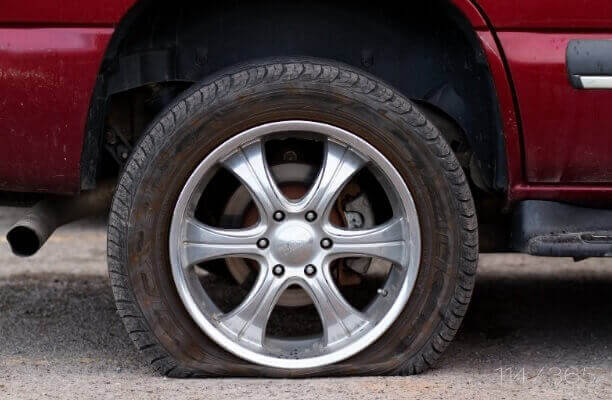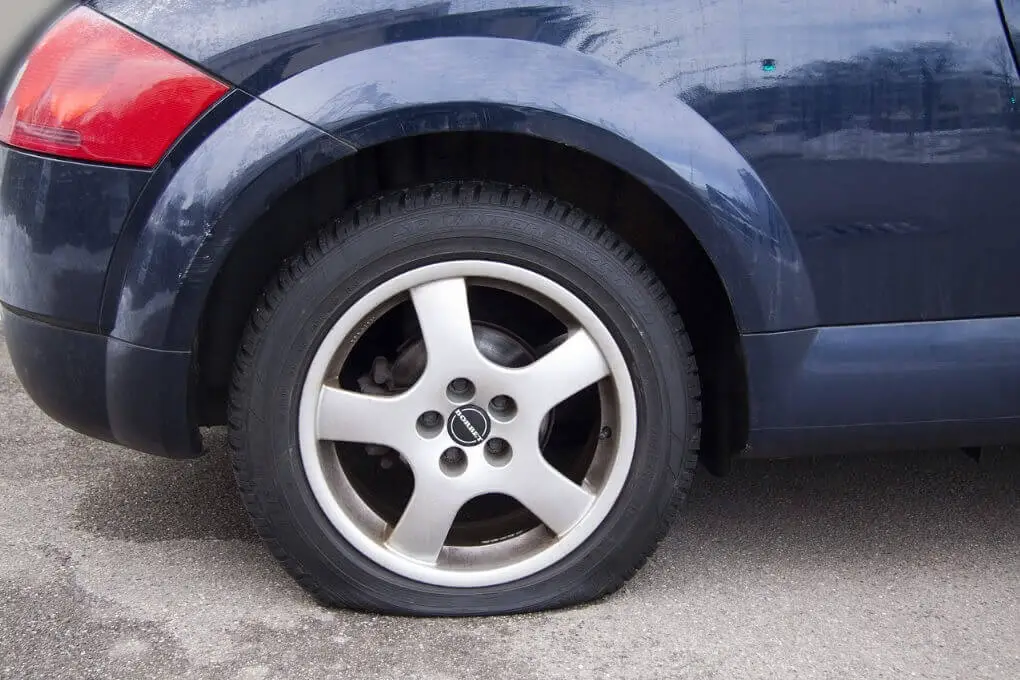Can you drive on a flat tire in an emergency? It’s not recommended to drive on a flat tire, even in an emergency, as it can cause significant damage to the tire, wheel, and suspension. If you must drive, keep the distance short and your speed under 20 mph to prevent further damage.
Having a flat tire is one of the most common and frustrating car problems. Whether it happens on the way to work, on a road trip, or while running errands, it can cause panic and stress. In some situations, especially in emergencies, you might be tempted to drive on a flat tire to reach a safer location, a service station, or a mechanic.
However, driving on a flat tire is generally not advisable, as it can cause further damage to the vehicle, compromise the safety, and lead to costly repairs. In this comprehensive guide, we’ll discuss why driving on a flat tire is risky, the potential damage it can cause, and the proper course of action you should take when you’re faced with a flat tire.

Contents
Flat Tire and Its Risks
A flat tire occurs when the tire loses air pressure, rendering it unable to support the weight of the vehicle properly. This can happen due to a puncture, valve damage, or even natural wear and tear. Depending on the type of tire and the severity of the flat, you might experience a variety of issues, from minor inconvenience to significant vehicle damage.
Different types of flat tires and how they can affect the car are discussed in below:
1. Puncture: A puncture occurs when a sharp object like a nail or screw enters the tire, causing a slow or rapid loss of air. While a puncture may seem like a minor issue, it can cause significant damage if the tire is driven on for too long.
2. Sidewall Damage: Damage to the sidewall of a tire, caused by hitting a pothole or curb, can be more severe. A flat due to sidewall damage can be difficult to repair, and driving on it can cause the tire to fail completely.
3. Blown Tire: A tire blowout occurs when the tire suddenly loses all its air pressure, often causing the vehicle to lose control. This is a dangerous situation, and driving on a blown tire is never recommended.
The Dangers of Driving on a Flat Tire
While it might seem like a quick fix to drive to a safer location or service station with a flat tire, this can actually make the situation much worse. Here’s why:
1. Tire and Wheel Damage
When a flat tire occurs, the weight of the vehicle is no longer properly supported by the tire, and the rim can come into direct contact with the road surface. This can cause significant damage to both the tire and the wheel. If you continue to drive, the tire may shred, and the wheel rim can get bent or cracked.
- Tire Shredding: Driving on a flat tire can cause it to unravel, leaving you with a damaged, irreparable tire.
- Wheel Rim Damage: The wheel rim may get bent, cracked, or scratched, which could lead to further complications and costly repairs.
2. Suspension and Alignment Problems
A vehicle’s suspension system is designed to handle the weight of the car, and it works in harmony with the tires. If you drive on a flat tire, you place undue stress on the suspension system and wheel alignment. This can lead to uneven wear on the suspension components and cause further issues, like poor handling, that may compromise your safety.
3. Increased Safety Risks
A flat tire can significantly affect the vehicle’s handling, making it harder to steer, brake, and maneuver. If you try to drive on a flat tire, your control over the car will decrease, which increases the chances of an accident or further damage to the car.
4. Damage to the Tire’s Internal Components
Modern tires are designed to work with a certain level of air pressure. When you drive on a flat tire, the internal components of the tire, such as the belts and layers, can suffer irreparable damage. Even if you manage to stop and replace the flat tire, the damage might be beyond repair, requiring a full replacement.

What Should You Do If You Have a Flat Tire in an Emergency?
While driving on a flat tire is risky, there are steps you can take to minimize the damage and get to safety. Here’s a detailed guide on what you should do if you find yourself with a flat tire.
1. Assess the Situation
Stay Calm: The first step is to remain calm. Driving with a flat tire can be disorienting, but it’s important to focus on what needs to be done to stay safe.
Turn on Hazard Lights: To warn other drivers, turn on your hazard lights as soon as you notice a flat tire.
Pull Over to a Safe Location: Try to move the vehicle to a safe place, such as the shoulder of the road or a parking lot, away from traffic. Avoid trying to drive any further on the flat tire if possible.
2. Check the Tire
Visual Inspection: If possible, inspect the tire from a safe distance to determine whether it’s a simple puncture, sidewall damage, or a more severe blowout.
Listen for Air Leaks: If you hear air escaping from the tire, it’s likely a puncture. If you hear nothing, it may be due to a sidewall issue or a total blowout.
3. Replace the Tire (If Possible)
Spare Tire: If you have a spare tire, it’s time to replace the flat one. Ensure you have the necessary tools such as a jack, lug wrench, and the spare tire itself.
Tire Sealant: If you have tire sealant and the puncture is small, you can use it to temporarily seal the hole and allow you to drive a short distance to the nearest service station.
4. Call for Roadside Assistance
If you’re unable to change the tire yourself, it’s time to call for professional help. Roadside assistance services can provide a tow or change the tire for you if necessary.
How Far Can You Drive on a Flat Tire?
Driving on a flat tire should always be avoided, but if you absolutely must drive a short distance to a safe location, it’s essential to limit the distance and speed.
- Distance: If you must drive, limit the distance to a few hundred feet. Driving any further can cause irreparable damage to the tire and wheel.
- Speed: Keep your speed under 20 mph (32 km/h) to reduce the risk of further damage.
Remember, these are temporary measures, and once you’re in a safe location, you should replace the tire or call for professional help.
Can You Drive on a Flat Tire with a Tire Repair Kit?
If you have a tire repair kit (sealant and compressor), you might be able to temporarily fix a small puncture in a flat tire. However, it’s important to understand that this is only a temporary fix, and driving on a sealed tire should be done with caution.
- Tire Sealant: Tire sealants can seal small punctures and re-inflate the tire. However, they do not work for large punctures or sidewall damage.
- Compressor: If the tire sealant kit includes a compressor, you can use it to add air and temporarily get back on the road.
Preventing Flat Tires
To reduce the risk of flat tires, follow these preventive tips:
- Check Tire Pressure Regularly: Maintain the recommended tire pressure to avoid tire damage from underinflation.
- Inspect Tires for Damage: Periodically check for visible damage, such as cracks, bulges, or foreign objects lodged in the tire.
- Avoid Road Hazards: Be cautious of sharp objects, potholes, and road debris that can puncture or damage tires.
Frequently Asked Questions
Here are some FAQs about driving on a flat tire –
1. Can I drive on a flat tire to a service station?
It is not advisable to drive on a flat tire. Doing so can cause significant damage to the tire, wheel, and suspension system. If you must drive, keep the distance and speed minimal.
2. How far can I drive on a flat tire?
You should only drive a few hundred feet, keeping your speed under 20 mph, to avoid further damage. Driving longer distances is unsafe and could cause irreversible damage to the tire and vehicle.
3. Can I use a tire sealant to fix a flat tire?
Yes, tire sealants can be used for small punctures as a temporary fix. However, they are not a permanent solution and should be replaced or professionally repaired as soon as possible.
4. What should I do if I don’t have a spare tire?
If you don’t have a spare tire, you can use a tire sealant or contact roadside assistance to have the tire replaced or repaired.
5. What causes flat tires in the first place?
Flat tires are usually caused by punctures from sharp objects, underinflation, overinflation, or damage to the tire’s sidewall. Regular tire maintenance and inspections can help reduce the risk.
Conclusion
Driving on a flat tire is never a good idea, even in an emergency. While you may be tempted to drive a short distance to reach a safe location, it’s essential to understand the risks and damage that can occur. Always prioritize safety and take immediate action to either replace the flat tire, use a tire sealant, or call for professional help.